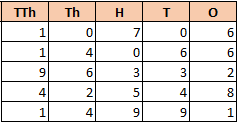Order Relations
Successor & Predecessor
A number that comes just after “a given” number is called its successor. It is one more than the given number.
A number that comes just before “a given” number is called its predecessor. It is one less than the given number.
Examples:

Comparison of Numbers
- When two numbers have different number of digits:
The number with more number of digits is greater than the other one.
Examples:
- Compare 292 and 76

Since, 292 has more number of digits.
So, 292 > 76
- Compare 2,298 and 26,676

Since, 2,298 has less number of digits.
So, 2,298 < 26,676
- Compare 4,98,726 and 57,46,225
![]()
Since, 4,98,726 has less number of digits.
So, 4,98,726 < 57,46,225.
- When two numbers have same number of digits
For numbers with same digits, we start comparing the digits with leftmost place in both numbers. The number with greater digit in the same place is greater.
Examples:
- Compare 381 and 981

Both are 3-digit numbers. We compare both the numbers starting from leftmost place and compare the digits of the two numbers. We see
3 Hundreds < 9 Hundreds
So, 381 < 981
- Compare 72,630 and 76,630
![]()
Both are 5-digit numbers. We compare both the numbers starting from leftmost place and compare the digits of the two numbers. We see
2 Thousands < 6 Thousands
So, 72,630 < 76,630
- Compare 52,62,781 and 52,26,781
![]()
Both are 7-digit numbers. We compare both the numbers starting from leftmost place and compare the digits of the two numbers. We see
6 Ten Thousands> 2 Ten Thousands
So, 52,62,781 > 52,26,781.
Ascending & Descending Order
- Ascending order is arranging the numbers from smallest to biggest number.
- Descending order is arranging the numbers from biggest to smallest number.
Examples:
Arrange the following in ascending and descending order
- 107: 409 : 333 : 548 : 991
- 10,706: 14,066: 96,332: 42,548 : 14,991
Solution:
(a) 107 : 409 : 333 : 548 : 991

Ascending Order:
107 < 333 < 409 < 548 < 991
Descending Order:
991 > 548 > 409 > 333 > 107
(b) 10,706: 14,066: 96,332 : 42,548 : 14,991

Ascending Order:
10,706 < 14,066 < 14,991 < 42,548 < 96,332
Descending Order:
96,332 > 42,548 > 14,991 > 14,066 > 10,706
Formation of Greatest and Smallest number
- To form the greatest number, the digits are arranged in descending order.
- To form the smallest number, the digits are arranged in ascending order.
Example:
Write the greatest and smallest 4-digit numbers using the given digits (without repetition).
- 3,8,1,6
Arranging the digits in descending order we get 8,6,3,1
So, the greatest 4-digit number is 8,631.
Arranging the digits in ascending order we get 1,3,6,8
So, the smallest 4-digit number is 1,368.
- 6,7,0,9
Arranging the digits in descending order we get 9,7,6,0
So, the greatest 4-digit number is 9,760.
Arranging the digits in ascending order we get 0,6,7,9
So, the smallest 4-digit number is 6,079.
Do Remember: While forming smallest numbers when “0” is given as a digit, “0” comes in the second place of the smallest number.
Fun Facts
- Zero is the only number known with so many names which include zip, zilch, nil, nought, naught.
- Googol is the number “one” followed by one hundred zeros. In fact, Google’s name came from misspelling of this word.




